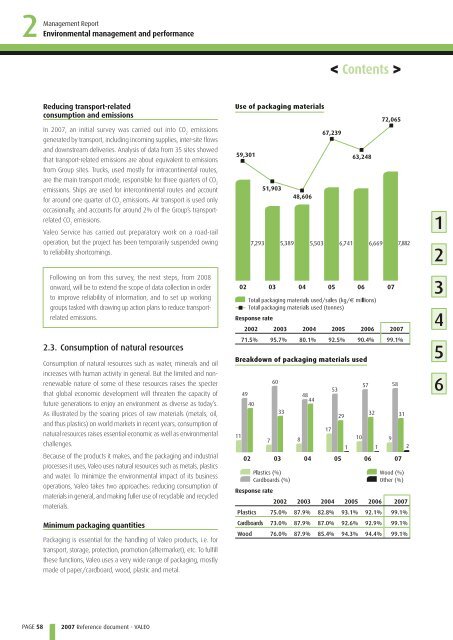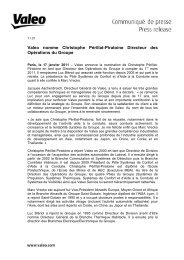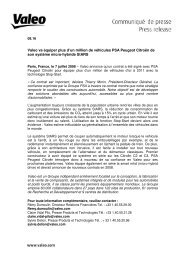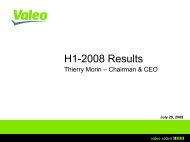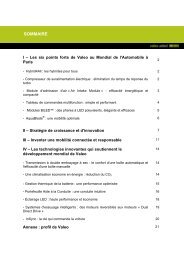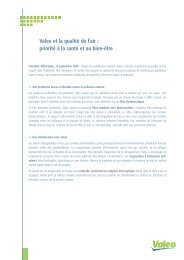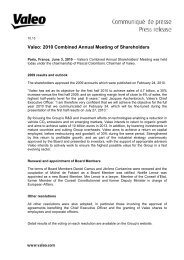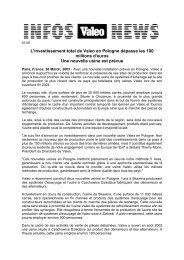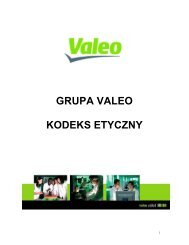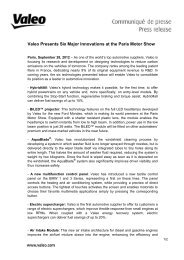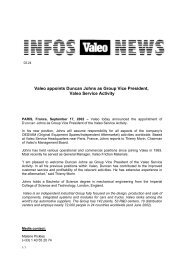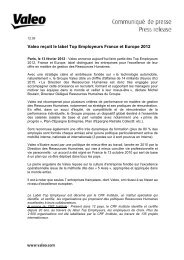2007 Reference document (PDF) - Valeo
2007 Reference document (PDF) - Valeo
2007 Reference document (PDF) - Valeo
You also want an ePaper? Increase the reach of your titles
YUMPU automatically turns print PDFs into web optimized ePapers that Google loves.
2 Management<br />
PAGE 58<br />
Report<br />
Environmental management and performance<br />
Reducing transport-related<br />
consumption and emissions<br />
In <strong>2007</strong>, an initial survey was carried out into CO emissions<br />
2<br />
generated by transport, including incoming supplies, inter-site flows<br />
and downstream deliveries. Analysis of data from 35 sites showed<br />
that transport-related emissions are about equivalent to emissions<br />
from Group sites. Trucks, used mostly for intracontinental routes,<br />
are the main transport mode, responsible for three quarters of CO2 emissions. Ships are used for intercontinental routes and account<br />
for around one quarter of CO emissions. Air transport is used only<br />
2<br />
occasionally, and accounts for around 2% of the Group’s transportrelated<br />
CO emissions.<br />
2<br />
<strong>Valeo</strong> Service has carried out preparatory work on a road-rail<br />
operation, but the project has been temporarily suspended owing<br />
to reliability shortcomings.<br />
Following on from this survey, the next steps, from 2008<br />
onward, will be to extend the scope of data collection in order<br />
to improve reliability of information, and to set up working<br />
groups tasked with drawing up action plans to reduce transportrelated<br />
emissions.<br />
2.3. Consumption of natural resources<br />
Consumption of natural resources such as water, minerals and oil<br />
increases with human activity in general. But the limited and nonrenewable<br />
nature of some of these resources raises the specter<br />
that global economic development will threaten the capacity of<br />
future generations to enjoy an environment as diverse as today’s.<br />
As illustrated by the soaring prices of raw materials (metals, oil,<br />
and thus plastics) on world markets in recent years, consumption of<br />
natural resources raises essential economic as well as environmental<br />
challenges.<br />
Because of the products it makes, and the packaging and industrial<br />
processes it uses, <strong>Valeo</strong> uses natural resources such as metals, plastics<br />
and water. To minimize the environmental impact of its business<br />
operations, <strong>Valeo</strong> takes two approaches: reducing consumption of<br />
materials in general, and making fuller use of recyclable and recycled<br />
materials.<br />
Minimum packaging quantities<br />
Packaging is essential for the handling of <strong>Valeo</strong> products, i.e. for<br />
transport, storage, protection, promotion (aftermarket), etc. To fulfill<br />
these functions, <strong>Valeo</strong> uses a very wide range of packaging, mostly<br />
made of paper/cardboard, wood, plastic and metal.<br />
<strong>2007</strong> <strong>Reference</strong> <strong>document</strong> - VALEO<br />
Use of packaging materials<br />
< Contents ><br />
Response rate<br />
2002 2003 2004 2005 2006 <strong>2007</strong><br />
71.5% 95.7% 80.1% 92.5% 90.4% 99.1%<br />
Breakdown of packaging materials used<br />
Response rate<br />
2002 2003 2004 2005 2006 <strong>2007</strong><br />
Plastics 75.0% 87.9% 82.8% 93.1% 92.1% 99.1%<br />
Cardboards 73.0% 87.9% 87.0% 92.6% 92.9% 99.1%<br />
Wood 76.0% 87.9% 85.4% 94.3% 94.4% 99.1%<br />
1<br />
2<br />
3<br />
4<br />
5<br />
6


